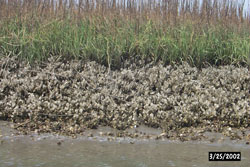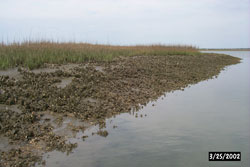Shellfish
Oyster Reef Ecology: Shoreline Erosion
Effects of Boat Wakes on Intertidal Oyster Reefs and Marshes in South Carolina
Coastal populations are increasing at an astounding rate. With increased development, recreational boating traffic increases. This is reflected in the burgeoning numbers of marinas, private docks, and boat ramps. Recreational boaters often utilize relatively small tidal creeks for fishing, crabbing and access to other bodies of water. In South Carolina tidal creeks are usually lined with Spartina marsh. Often a fringe of oyster bank separates the marsh from the main channel. These oyster banks dissipate wave energy and serve as a protective barrier for the marsh grass.
 |
 |
Motor boats and jetskis operating in small tidal creeks create wakes which can damage the shoreline. Damage often begins with disruption of the oyster bank. Once the oyster bank is damaged, it is a less effective barrier and erosion increases. Eventually, the oyster bank may be totally destroyed. As the oyster bank is lost, the marsh line begins to erode. In severe erosion cases, entire sections of marsh "slump" into the water.
 |
 |
 |
 |
Photos courtesy of SC Coastal Conservation League
The shellfish research section has been evaluating relationships between boat wakes and shoreline erosion issues including:
- The effect of boat wakes on the rate of erosion of small tidal creek stream banks.
- The effect of natural and restored oyster reefs on stream bank erosion rates.
